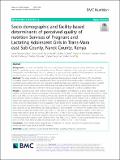| dc.contributor.author | David Omondi Okeyo, Sussy Gumo, Elly O Munde, Charles O Opiyo, Zablon O Omungo, Maureen Olyaro, Rachel K Ndirangu, Nanlop Ogbureke, Sophie Efange, Collins Ouma | |
| dc.date.accessioned | 2020-07-16T12:47:57Z | |
| dc.date.available | 2020-07-16T12:47:57Z | |
| dc.date.issued | 2019-12-01 | |
| dc.identifier.uri | https://repository.maseno.ac.ke/handle/123456789/1515 | |
| dc.description | It has been established that use and utilization of nutrition services among adolescents are highly linked to availability, access, cost and quality of care. The main objective of this study was to assess the socio-demographic and facility-based factors as proxies to access to perceived quality of nutrition-specific and nutrition-sensitive services among adolescents in Trans-Mara East Sub-County, Narok County.
Methods
The study adopted a cross-sectional approach that employed mixed methods on 291 households. Probability proportionate to size sampling techniques using cluster and simple random methods were used to practically access adolescents who are pregnant or lactating. Data were collected using questionnaires, in-depth interview and Focus Group Discussion. Quantitative data was analyzed descriptively using frequencies and … | en_US |
| dc.description.abstract | Background: It has been established that use and utilization of nutrition services among adolescents are highly
linked to availability, access, cost and quality of care. The main objective of this study was to assess the sociodemographic and facility-based factors as proxies to access to perceived quality of nutrition-specific and nutritionsensitive services among adolescents in Trans-Mara East Sub-County, Narok County.
Methods: The study adopted a cross-sectional approach that employed mixed methods on 291 households.
Probability proportionate to size sampling techniques using cluster and simple random methods were used to
practically access adolescents who are pregnant or lactating. Data were collected using questionnaires, in-depth
interview and Focus Group Discussion. Quantitative data was analyzed descriptively using frequencies and
inferentially using odds ratio and Z-test. Framework analysis was employed to analyze qualitative data.
Results: A nutritionist was more likely to increase overall utilization (considered as a proxy index to access quality
nutrition-sensitive and -specific services) by 3.18 times (OR = 3.18, 95% CI = 1.50–6.60, P = 0.002) and nurses 2.7 times
(OR = 2.70, 95% CI = 1.40–5.30, P = 0.005). Generally, 80.7 and 69.4% attached positive value to environmental and
basic personal hygiene, respectively, as being areas of nutrition-sensitive service delivery with a significant number
higher than expected frequency of 50% (P < 0.05). An assessment of facility networks isolated only public health
center as the key determinant of overall utilization. Public health centers among other health facilities were more
likely to increase utilization (OR = 4.52, 95% CI = 1.50–13.50, P = 0.007). Assessment of distance to facility identified
both distances as key determinants of overall utilization as those resident < 1 km from the facilities were 2.4 times
more likely to utilize the facilities (OR = 2.42, 95% CI = 1.20–4.80, P = 0.012) while those resident 1-5 km were 5.3
times more likely to utilize the services (OR = 5.34, 95% CI = 1.90–15.10, P = 0.002) relative to longer distances.
Finally, on methods of conveying messages, those who received messages through Information Education and
Communication (IEC) materials were 7.8 times (OR = 7.85, 95% CI = 1.50–40.50, P = 0.014) and through face-to-face
were 3.9 times more likely to utilize the services (OR = 3.91, 95% CI = 1.30–11.90, P = 0.016).
Conclusion: Critical facility-based determinants of utilization of nutrition services include personnel (mainly
nutritionist and nurse), distance and IEC materials.
Keywords: Quality, Nutrition, Facility-based determinates, Lactating, Pregnant, Adolescent | en_US |
| dc.publisher | BioMed Central | en_US |
| dc.subject | Quality, Nutrition, Facility-based determinates, Lactating, Pregnant, Adolescent | en_US |
| dc.title | Socio-demographic and facility-based determinants of perceived quality of nutrition Services of Pregnant and Lactating Adolescent Girls in Trans-Mara east Sub-County, Narok County, Kenya | en_US |
| dc.type | Article | en_US |

